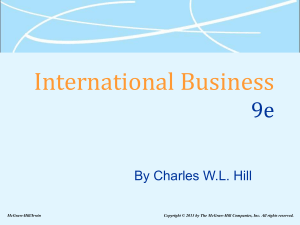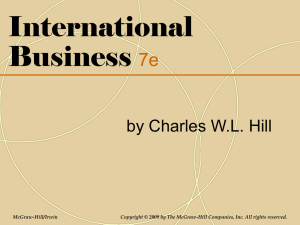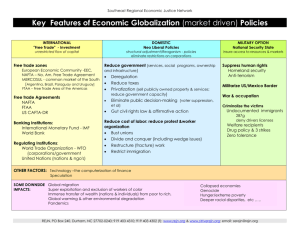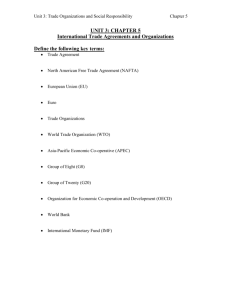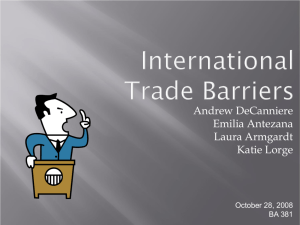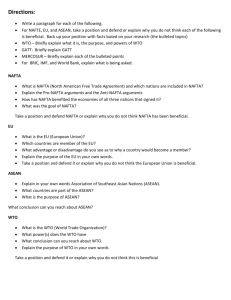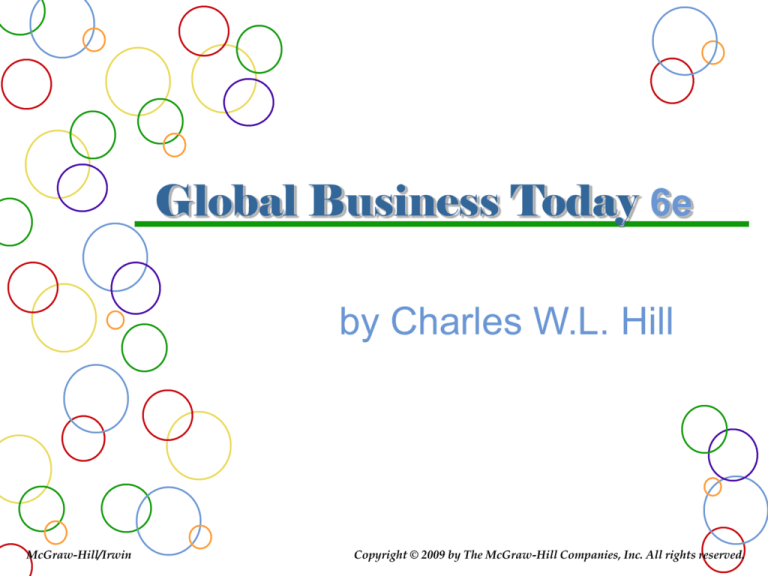
Global Business Today 6e
by Charles W.L. Hill
McGraw-Hill/Irwin
Copyright © 2009 by The McGraw-Hill Companies, Inc. All rights reserved.
Chapter 8
Regional Economic
Integration
Introduction
Regional economic integration refers to
agreements between countries in a
geographic region to reduce tariff and
non-tariff barriers to the free flow of
goods, services, and factors of
production between each other
In theory, regional economic integration
benefits all members
Over the last two decades, the number
of regional trade agreements has been
on the rise
8-3
Introduction
Question: Is regional economic integration a
good thing?
While regional trade agreements are designed
to promote free trade, there is some concern
that the world is moving toward a situation in
which a number of regional trade blocks
compete against each other
If this scenario materializes, the gains from free
trade within blocs could be offset by a decline in
trade between blocs
8-4
Levels of Economic Integration
There are five levels of economic integration
1. Free trade area - all barriers to the trade of
goods and services among member countries
are removed, but members determine their own
trade policies with regard to nonmembers
This is the most popular form of integration
Examples include
the European Free Trade Association
(between Norway, Iceland, Liechtenstein,
and Switzerland)
the North American Free Trade Agreement
(between the U.S., Canada, and Mexico)
8-5
Levels of Economic Integration
Levels of Economic Integration
8-6
Levels of Economic Integration
2. Customs union - eliminates trade
barriers between member countries and
adopts a common external trade policy
Most countries that enter a customs
union desire further integration in the
future
Examples include
the Andean Pact (between Bolivia,
Columbia, Ecuador, Venezuela, and
Peru)
8-7
Levels of Economic Integration
3. Common market - no barriers to trade between
member countries, a common external trade
policy, and the free movement of the factors of
production
This type of integration can be difficult to
achieve and requires significant harmony
among members in fiscal, monetary, and
employment policies
Examples include
MERCOSUR (between Brazil, Argentina,
Paraguay, and Uruguay) hope to achieve this
status
8-8
Levels of Economic Integration
4. Economic union - involves the free flow of
products and factors of production between
members, the adoption of a common external
trade policy, and in addition, a common
currency, harmonization of the member
countries’ tax rates, and a common monetary
and fiscal policy
This level of integration involves sacrificing a
significant amount of national sovereignty
Examples include
the European Union (EU)
8-9
Levels of Economic Integration
5. Political union - independent states are
combined into a single union
This requires that a central political
apparatus coordinate economic, social,
and foreign policy for member states
The EU is headed toward at least partial
political union, and the United States is
an example of even closer political union
8-10
Classroom Performance System
In a _______, all barriers to the free flow of
goods and services between member
countries are removed, and a common
policy toward nonmembers is established
a) Free trade area
b) Customs union
c) Common market
d) Economic union
8-11
Classroom Performance System
The European Union is an example of a(n)
a) Free trade area
b) Customs union
c) Common market
d) Economic union
8-12
The Case for Regional Integration
There are both economic and political
arguments supporting regional economic
integration
Generally, many groups within a country
oppose the notion of economic
integration
8-13
The Economic Case for Integration
Regional economic integration is an
attempt to achieve additional gains from
the free flow of trade and investment
between countries beyond those
attainable under international
agreements such as the WTO
Since it is easier to form an agreement
with a few countries than across all
nations, there has been a push toward
regional economic integration
8-14
The Political Case for Integration
Politically, integration is attractive because
by linking countries together, making them
more dependent on each other, and forming
a structure where they regularly have to
interact, the likelihood of violent conflict and
war will decrease
by linking countries together, they have
greater clout and are politically much
stronger in dealing with other nations
8-15
Impediments to Integration
Integration is not easy to achieve or
maintain
There are two main impediments to
integration
1. it can be costly - while a nation as a
whole may benefit from a regional
free trade agreement, certain groups
may lose
2. it can result in a loss of national
sovereignty
8-16
The Case Against
Regional Integration
Regional economic integration only
makes sense when the amount of trade
it creates exceeds the amount it diverts
Trade creation occurs when low cost
producers within the free trade area
replace high cost domestic producers
Trade diversion occurs when higher cost
suppliers within the free trade area
replace lower cost external suppliers
8-17
Regional Economic Integration
in Europe
Europe has two trade blocs
the European Union with 27 members
the European Free Trade Association
with 4 members
The European Union is expected to
become a superpower of the same order
as the United States
8-18
Evolution of the European Union
The European Union (EU) is the result of
the devastation of two world wars on
Western Europe and the desire for a lasting
peace
the desire by the European nations to hold
their own on the world’s political and
economic stage
The forerunner of the EU was the European
Coal and Steel Community (formed in 1951)
The Treaty of Rome established the European
Economic Community in 1957
The name was changed to the EU in 1994
8-19
Evolution of the European Union
Member States of the European Union in
2008
8-20
Political Structure of
the European Union
The four main institutions of the EU are
1. the European Commission - proposes
EU legislation, implements it, and
monitors compliance
2. the European Council - the ultimate
controlling authority within the EU
3. the European Parliament - debates
legislation proposed by the commission
and forwarded to it by the council
4. the Court of Justice - the supreme
appeals court for EU law
8-21
The Single European Act
The Single European Act (1987) committed EC countries
to work toward establishment of a single market by 1992
The Act was born out of frustration among EC members
that the community was not living up to its promise
The Act proposed to
remove all frontier controls between EC countries
apply the principle of mutual recognition to product
standards
open procurement to non-national suppliers
lift barriers to competition in retail banking and
insurance
remove all restrictions on foreign exchange
transactions between member countries
abolish restrictions on cabotage
The Act prompted the restructuring of substantial sectors
of European Industry
8-22
The Establishment of the Euro
The Maastricht Treaty (1991) committed EU
members to adopt a single currency, the euro
The euro is used by 15 of the 27 member
states
This has created the euro zone, the second
largest currency zone in the world after that
of the U.S. dollar
Countries that participate have agreed to
give up control of their monetary policy
So far, Britain, Denmark and Sweden have
opted out of the euro zone
8-23
The Establishment of the Euro
Question: What are the benefits of the euro?
Firms and individuals should save by handling
one currency, rather than many
Consumers should find it easier to compare
prices across Europe
Producers should become more efficient as
they reduce their production costs in order to
maintain their profit margins
The highly liquid pan-European capital market
should get a strong boost
The range of investment options open both to
individuals and institutions should increase
8-24
The Establishment of the Euro
Question: What are the costs of the euro?
Membership in the euro zone implies that
nations lose control over the monetary policy
The European Central Bank (ECB) was
established to manage monetary policy, but
some question its ability to act independently
The EU is not an optimal currency area (an
area where similarities in the underlying
structure of economic activities make it feasible
to adopt a single currency and use a single
exchange rate as an instrument of macroeconomic policy)
So, countries may react very differently to
changes in the euro
8-25
The Establishment of the Euro
Since its establishment the euro has had
a volatile trading history with the U.S.
dollar
Initially, the euro was valued at $1.17,
then fell in value relative to the dollar, but
strengthened to an all-time high of $1.54
in March 2008
8-26
Enlargement of
the European Union
Many countries, particularly from Eastern
Europe, have applied for membership in
the EU
Ten countries joined in 2004 expanding
the EU to 25 states, with population of
450 million people, and a single
continental economy with a GDP of €11
trillion
In 2007, Bulgaria and Romania joined
bringing membership to 27 countries
Turkey has also applied for membership
8-27
Classroom Performance System
The ultimate decision making body of the
European Union is the
a) Council of the European Union
b) European Parliament
c) Court of Justice
d) European Commission
8-28
Regional Economic Integration
in the Americas
Regional economic integration is on the
rise in the Americas
The most significant attempt is the
North American Free Trade
Agreement
Other agreements include
the Andean Community
MERCOSUR
There are also attempts to form a Free
Trade Area of the Americas
8-29
Regional Economic Integration
in the Americas
Regional Integration in the Americas
8-30
The North American
Free Trade Agreement
The North American Free Trade Agreement (NAFTA)
between the U.S., Canada, and Mexico became law in
1994
NAFTA
abolished tariffs on 99 percent of goods traded
removed barriers on the cross-border flow of services
protects intellectual property rights
allows each country to apply its own environmental
standards
establishes two commissions to impose fines and
remove trade privileges when environmental
standards or legislation involving health and safety,
minimum wages, or child labor are ignored
8-31
The North American
Free Trade Agreement
Question: What are the benefits of NAFTA?
Mexico will benefit from increased jobs as low
cost production moves south, and will attain
more rapid economic growth as a result
The U.S. and Canada will benefit from the
access to a large and increasingly prosperous
market and from the lower prices for consumers
from goods produced in Mexico
U.S. and Canadian firms with production sites in
Mexico will be more competitive on world
markets
8-32
The North American
Free Trade Agreement
Question: What are the drawbacks of NAFTA?
Jobs could be lost and wage levels could
decline in the U.S. and Canada
Mexican workers could emigrate north
Pollution could increase due to Mexico's more
lax standards
Mexico would lose its sovereignty
8-33
The North American
Free Trade Agreement
Question: How successful has NAFTA been?
Studies of NAFTA’s early impact suggest that
both advocates and detractors may have been
guilty of exaggeration
Trade between the three countries has
increased by 250 percent
The members have become more integrated
Productivity has increased in member
nations
Employment effects have been small
Mexico has become more politically stable
8-34
The North American
Free Trade Agreement
Question: Should NAFTA accept new members?
Several other Latin American countries have
indicated their desire to eventually join NAFTA
Currently both Canada and the U.S. are
adopting a wait and see attitude with regard to
most countries
8-35
Classroom Performance System
Studies show that after its first decade
a) There was a small net gain of jobs in the
U.S.
b) Exports from the U.S. failed to grow
c) NAFTA’s overall impact has been
significant
d) The U.S., Canada, and Mexico all
experienced a decrease in productivity
8-36
The Andean Community
The Andean Pact (formed in 1969) was based
on the EU model
The agreement had more or less failed by the
mid-1980s
In the late 1980s, Latin American governments
began to adopt free market economic policies
In 1990, the Andean Pact was re-launched, and
now operates as a customs union
In 2003, it signed an agreement with
MERCOSUR to restart negotiations towards the
creation of a free trade area
Current members include Bolivia, Ecuador,
Peru, and Columbia
8-37
MERCOSUR
MERCOSUR originated in 1988 as a free trade
pact between Brazil and Argentina
In 1990, it was expanded to include Paraguay
and Uruguay
MERCOSUR has been successful at reducing
trade barriers between member states
However, critics worry that MERCOSUR is
diverting trade rather than creating trade, and
local firms are investing in industries that are
not competitive on a worldwide basis
Current members include Brazil, Argentina,
Paraguay, Uruguay, and Venezuela
8-38
Central American Common Market,
CAFTA and CARICOM
Two other trade pacts in the Americas are
1. the Central American Trade Market
Current members are Costa Rica, El
Salvador, Guatemala, Honduras, Nicaragua,
and the Dominican Republic
These countries were joined by the U.S. in 2003
to create a free trade agreement, the Central
American Free Trade Agreement (2003)
2. CARICOM (1973), a customs union between
English-speaking Caribbean countries
Six members formed the Caribbean Single
Market and Economy (CSME) in 2006 to lower
trade barriers and harmonize macro-economic
and monetary policy
8-39
Free Trade of the Americas
Talks began in 1998 to establish a Free
Trade of The Americas (FTAA) by 2005
The FTAA was not established as
planned
Current support for the agreement by the
U.S. and Brazil is limited
If the FTAA is established, it would create
a free trade area of nearly 800 million
people
8-40
Regional Economic
Integration Elsewhere
There have been various attempts at
regional economic integration throughout
Asia and Africa
The success of these attempts have
been limited
The most significant efforts are the
Association of Southeast Asian Nations
and the Asia-Pacific Economic
Cooperation
8-41
Association of
Southeast Asian Nations
The Association of Southeast Asian Nations
(ASEAN) was formed in 1967
ASEAN currently includes Brunei, Indonesia,
Malaysia, the Philippines, Singapore, Thailand,
Vietnam, Myanmar, Laos, and Cambodia
The goal of ASEAN is to foster freer trade
between member countries and to achieve
some cooperation in their industrial policies
In 2003, an ASEAN Free Trade Area (AFTA)
between the six original members of ASEAN
came into full effect with a goal of reducing
import tariffs among the older members
Vietnam, Laos, and Myanmar have all joined
AFTA more recently
8-42
Asia-Pacific Economic Cooperation
Asian Pacific Economic Cooperation
(APEC) was founded in 1990
APEC currently has 21 members
including the United States, Japan, and
China
APEC wants to increase multilateral
cooperation in view of the economic rise
of the Pacific nations and the growing
interdependence within the region
8-43
Regional Trade Blocs in Africa
There are nine trade blocs on the African
continent
However progress toward the
establishment of meaningful trade blocs
has been slow
Many countries believe that they need to
protect their industries from unfair foreign
competition making it difficult to create
free trade areas or customs unions
8-44
Implications for Managers
Question: Why is regional economic integration
important to international companies?
Thanks to regional economic integration,
markets that had been protected from foreign
competition are increasingly open
These developments are particularly significant
in the European Union and NAFTA
However, regional economic integration is likely
to increase competition
8-45
Opportunities
Formerly protected markets are now
open to exports and direct investment
Because of the free movement of goods
across borders, the harmonization of
product standards, and the simplification
of tax regimes, firms can realize
potentially enormous cost economies by
centralizing production in those locations
where the mix of factor costs and skills is
optimal
8-46
Threats
Lower trade and investment barriers could lead
to increased price competition within the EU
and NAFTA
Increased competition within the EU is forcing
EU firms to become more efficient, and stronger
global competitors
Firms outside the blocs risk being shut out of
the single market by the creation of a “trade
fortress”
Firms may be limited in their ability to pursue
the strategy of their choice in the EU intervenes
and imposes conditions on companies
proposing mergers and acquisitions
8-47
Critical Discussion Question
1. NAFTA has produced significant net
benefits for the Canadian, Mexican, and
U.S. economy. Discuss.
8-48
Critical Discussion Question
2. What are the economic and political
arguments for regional economic
integration? Given these arguments,
why don’t we see more substantial
examples of integration in the world
economy?
8-49
Critical Discussion Question
3. What effect is creation of a single market
and a single currency within the EU likely
to have on competition within the EU?
Why?
8-50
Critical Discussion Question
4. Do you think it is correct for the
European Commission to restrict
mergers between American companies
that do business in Europe? (For
example, the European Commission
vetoed the proposed merger between
WorldCom and Sprint, both U.S.
companies, and it carefully reviewed the
merger between AOL and TimeWarner,
again both U.S. companies.)
8-51
Critical Discussion Question
5. How should a U.S. firm that currently
only exports to ASEAN countries
respond to the creation of a single
market in this regional grouping?
8-52
Critical Discussion Question
6. How should a firm that has self-sufficient
production facilities to in several ASEAN
countries respond to the creation of a
single market? What are the constraints
on its ability to respond in a manner that
minimizes production costs?
8-53
Critical Discussion Question
7. After a promising start, in the last few
years, MERCOSUR, the major Latin
American trade agreement, has faltered
and made little progress since 2000.
What problems are hurting
MERCOSUR? What can be done to
solve these problems?
8-54
Critical Discussion Question
8. Would the establishment of a Free Trade Area
of the Americas (FTAA) be good for the two
most advanced economies of the hemisphere,
the United States and Canada? How might the
establishment of the FTAA impact the strategy
of North American firms?
8-55
Critical Discussion Question
9. Reread the Management Focus case on the European
Commission and Media Industry Mergers, then answer
the following questions:
a) Given that both AOL and Time Warner were U.S. based
companies, do you think the European Commission had a
right to review and regulate their planned merger?
b) Were the concessions extracted by the European
Commission from AOL and Time Warner reasonable?
Whose interests was the Commission trying to protect?
c) What precedent do the actions of the European
Commission in this case set? What are the implications
for managers of foreign enterprises with substantial
operations in Europe?
8-56

